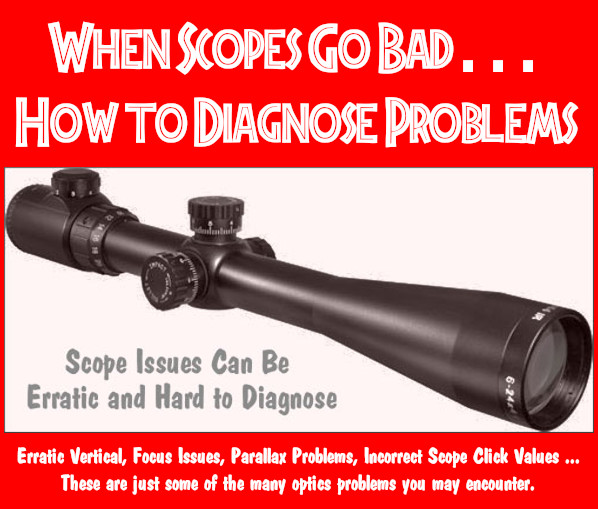Riflescopes have mechanical components. One of the sad truths about precision shooting is you will eventually experience a scope malfunction. If you’re fortunate, it won’t occur during a National-level event. It’s best if the failure is dramatic and obvious so you don’t have to spend months trying isolate the problem. Scope problems can be difficult to diagnose or erratic. You may have unidentified flyers, or a slight loss of accuracy, and not know how to diagnose it. It can be difficult to diagnose a 1/8th MOA click scope when it starts failing because the POI changes are so slight. How to Diagnose Scope Issues If you notice that your groups are opening up, it’s likely due to poor wind reading or another “driver error”. My experience taught me that scopes can go bad. If your accuracy starts to decline without any other explanation, it could be that your optics are the culprit. Here are some “symptoms” that your scope is having problems: 1. The point of impact of a shot can vary greatly from shot to shot, even with known accurate loads. 2. Uneven tracking (vertical or horizontal)
3. Clicking on the Change Point of Impact button does not change the point of impact.
4. Inability to zero a reasonable number of shots.
5. Unexpected changes in the elevation click values (compared with previous known distances come-ups).
6. Visible shift of the reticle away from the center of view.
7. Clicking with a different “feel” or resistance.
8. Inability to set the parallax for sharpness.
9. Turrets and other controls may feel loose or wobbly.
10. When the gun is moved, internal scope components shake. Even expensive scopes may fail or perform erratically, and this can happen without warning or apparent reason. Here are some warning signs that your scope may be malfunctioning. 1. The click count has increased significantly since the zero established at the known range.
2. Turrets may feel wobbly or have a different “click” when you rotate them.
3. Inability to adjust Adjustable Objective or Side Focus to get a sharp target image.
4. The click value is different from the shot point of impact after elevation/windage changes. When you dial 2 MOA up, but observe a rise of 6 MOA in POI. When An Expensive Sight Goes Bad – Crazy Vertical Case Study A few years ago, this editor’s 8-25x50mm brand scope went bad. How did I know that I had a problem with my scope? The first sign I saw was a “drop-down flyer” at a 600 yard match. After a two target relay, I looked at my targets. My first 5-shots group had five shots that were centered fairly well, and in a range of about 2.2″ It was pretty good. Everything was working fine. Then I looked again at the second target. I was attracted to four shots that were all centered on the 10 Ring and measured about 2.4″. Then I saw the fifth shot. It was 18” below the X, straight down. If you draw a straight line from the center of the “X”, it would almost pass through the fifth shot. Is my scope actually malfunctioning or is this driver error?
It was very disconcerting. But since I’d never had a problem with this scope, I assumed that it was a loading issue (too much powder? It could have been a driver error, or I could have flinched and yanked on the trigger. I did not do anything to fix the scope because I thought the problem was either me or the load. The Problems Reappear – Huge POI swings confirm this scope is toast
The next range session was a disaster. In three shots I managed to hit steel at 600 with my usual come-up. Everything appeared to be fine. Then I switched to using paper. After five shots, a friend in the pits using a walkie talkie radioed to say that he could not see any bullet holes on the paper. My spotter told me he thought that the bullets had hit the dirt just below the paper. I thought we could add 3 MOA (12 clicks) and that would raise POI to 18”, and I’d be on the paper, near the center. It didn’t work – now the bullets were hitting the berm above the target frame. The POI was now 48” away (8 MOA). (And no, I didn’t click too fast — I clicked slowly and counted each click as I adjusted elevation. To compensate, I removed 8 clicks. This should be 2 MOA (12”) or 8 clicks. No joy. The POI dropped by about 24″ (4 MOA) while the POI moved by 18″ right to the edge of target. We “chased center” for the next 20 shots to try and zero the gun at 600 yards. We never did. We gave up after burning through a lot ammo. I set the zero to 100 yards, as is my usual practice, before stowing my gun for the return trip (47 clicks lower than 600 yard zero). I noticed immediately that the “feeling” of the knob was not right. I was able to get the clicks to feel tight even though I was at the center of my elevation. (I have a +20MOA scope mount). The clicks were very stiff and didn’t move as much as they should have. It seemed like I had four or five clicks “bunched up” and with a lot resistance, then the next one would have almost zero resistance and jump. It’s hard for me to describe it, but it felt like winding a very loose spring that was erratic. I told my shooting buddies that I thought the scope had taken a dump. I let one of them work the elevation knob for a little while. “That feels strange,” he said. “The clicks aren’t consistent… at first, it doesn’t want to move and then they jump too easily.” Convinced I had a problem, I packed up the scope and sent it to the manufacturer. Was I hallucinating or was it just a driver error? Was it really a driver error? I’ve heard many stories about guys who sent their scopes to be repaired, only to get them back with a short note that said: “Scope has passed inspection and function tests 100%.” No repairs required”. Was my scope really a FUBAR? Yes, it was. The scope was returned to the factory with a Repair Record that stated that almost all internal mechanicals were replaced or repaired: “Replaced adjustment elevation; Replaced adjustment windage; Reworked erector system; Reworked selector; Reworked parallax control.”
My scope had a slightly canted, factory-installed reticle. However, it worked perfectly for many years. I was able, for more than five years, to switch between 100-yard and 600-yard zeros with perfect repeatability. I had confidence in this scope. Why did it fail? My theory is that the turrets are side-loaded. I used to carry my gun in a thick, soft case. I recently switched to a hard case with an aluminum side and a dense egg-crate-foam interior. I noticed that it took some effort for me to close the case even though it was large enough to hold the gun. My theory is that the foam was not compressing enough and caused a side-load to the windage turret after the case was closed. This is my best guess, but it may not be the true cause of the problem. As I explained at the beginning of this article, scopes, like any mechanical system, can stop working without apparent cause.

















